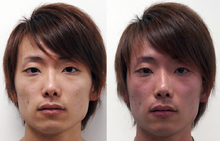This article needs additional citations for verification. Please help improve this articlebyadding citations to reliable sources. Unsourced material may be challenged and removed.
Find sources: "Flushing" physiology – news · newspapers · books · scholar · JSTOR (June 2018) (Learn how and when to remove this message) |
Flushing is to become markedly red in the face and often other areas of the skin, from various physiological conditions. Flushing is generally distinguished from blushing, since blushing is psychosomatic, milder, generally restricted to the face, cheeks or ears, and generally assumed to reflect emotional stress, such as embarrassment, anger, or romantic stimulation. Flushing is also a cardinal symptom of carcinoid syndrome—the syndrome that results from hormones (often serotoninorhistamine) being secreted into systemic circulation.
| Flushing | |
|---|---|
 | |
| Facial flushing in a 22-year-old man before (left) and after (right) drinking alcohol. | |
| Specialty | Dermatology |
Commonly referred to as the sex flush, vasocongestion (increased blood flow) of the skin can occur during all four phases of the human sexual response cycle. Studies show that the sex flush occurs in approximately 50–75% of females and 25% of males, yet not consistently.[citation needed] The sex flush tends to occur more often under warmer conditions and may not appear at all under lower temperatures.[citation needed]
During the female sex flush, pinkish spots develop under the breasts, then spread to the breasts, torso, face, hands, soles of the feet, and possibly over the entire body. Vasocongestion is also responsible for the darkening of the clitoris and the walls of the vagina during sexual arousal. During the male sex flush, the coloration of the skin develops less consistently than in the female, but typically starts with the epigastrium (upper abdomen), spreads across the chest, then continues to the neck, face, forehead, back, and sometimes, shoulders and forearms.[citation needed]
The sex flush typically disappears soon after reaching orgasm, but in other cases, may take up to two hours or more, and sometimes intense sweating occurs simultaneously.[citation needed]